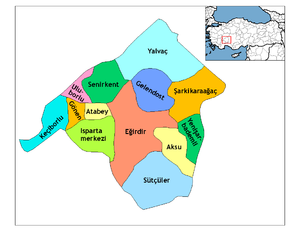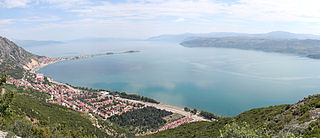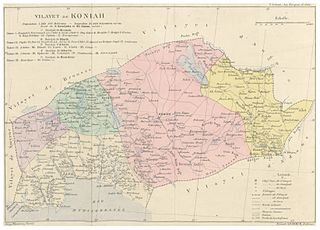
Below is the list of populated places in Isparta Province, Turkey by the districts. [1] In the following lists first place in each list is the administrative center of the district.

Below is the list of populated places in Isparta Province, Turkey by the districts. [1] In the following lists first place in each list is the administrative center of the district.

Isparta Province is a province in southwestern Turkey. Its adjacent provinces are Afyon to the northwest, Burdur to the southwest, Antalya to the south, and Konya to the east. Its area is 8,946 km2, and its population is 445,325 (2022). The provincial capital is Isparta.

The Vilayet of Konya was a first-level administrative division (vilayet) of the Ottoman Empire in Asia Minor which included the whole, or parts of, the ancient regions of Pamphylia, Pisidia, Phrygia, Lycaonia, Cilicia and Cappadocia.
Yaka is a village in Gelendost District, Isparta Province, Turkey. Its population is 1,552 (2022). Before the 2013 reorganisation, it was a town (belde).

The 81 provinces of Turkey are divided into 973 districts. In the Ottoman Empire and in the early Turkish Republic, the corresponding unit was the kaza.
Felek al-Din Dündar Beg was Beg (ruler) of Hamid, in southwestern Anatolia, from c. 1300 until his death. Felek al-Din changed his headquarters from Uluborlu to Eğirdir, which he renamed to Felekabad after himself. Although Dündar occasionally declared his loyalty to the Ilkhanate in the east, he expanded his territory in times of internal struggles the Ilkhanate faced. He captured Antalya and appointed his brother Yunus as its ruler, forming the Teke branch of the Hamidids. Emboldened by his victories, Dündar declared himself a sultan and minted coins without the mention of an overlord. On the other hand, the Ilkhanid governor of Anatolia, Timurtash led an extensive campaign to restore the Ilkhanid authority over the Turkmen rulers in the western frontier of Anatolia, such as Dündar. Upon the siege of Felekabad, Dündar sought protection under his nephew Mahmud in Antalya. Mahmud did not resist Timurtash and surrendered his uncle to him. Dündar was executed by Timurtash and would be succeeded by his son Khidr Beg.

Kızıldağ National Park, established on May 19, 1969, is a national park in southern Turkey. It is located in the Yenişarbademli-Şarkikaraağaç-Aksu districts of Isparta Province.

The Isparta Angle is an inverse-V-shaped morphotectonic structure located in southwestern Anatolia, to the north of the Gulf of Antalya. Formed by the intersection of the Aegean and Cyprian tectonic arcs, and located between the continental Bey Dağları and Anatolian blocks, the Isparta Angle is a geologically complex area with many nappes of diverse ages and origins that were pushed onto the Menderes-Tauride platform. The Isparta Angle is a result of the Anatolian Plate's rotation from the early Paleocene to the early Pliocene. This is a very seismically active area. It is "characterized by a series of grabens and horsts" separated by active faults.

Eğirdir District is a district of the Isparta Province of Turkey. Its seat is the town of Eğirdir. Its area is 1,315 km2, and its population is 30,854 (2022).

Gelendost District is a district of the Isparta Province of Turkey. Its seat is the town of Gelendost. Its area is 610 km2, and its population is 14,678 (2022).

Şarkikaraağaç District is a district of the Isparta Province of Turkey. Its seat is the town of Şarkikaraağaç. Its area is 1,068 km2, and its population is 24,660 (2022).

Sütçüler District is a district of the Isparta Province of Turkey. Its seat is the town of Sütçüler. Its area is 1,235 km2, and its population is 9,869 (2022).

Yalvaç District is a district of the Isparta Province of Turkey. Its seat is the town of Yalvaç. Its area is 1,402 km2, and its population is 45,931 (2022).
Hamid Beg was the eponymous founder of the Hamidids in southwestern Anatolia. Hamid Beg's tribe originally inhabited northern Syria and later migrated to Anatolia. He served under the Sultanate of Rum by giving military training to the ruler Kayqubad I's children and army. In 1240, Kayqubad's successor, Kaykhusraw II, granted Hamid Beg land around Isparta and Burdur as the local frontier commander. The Mongol conquests gradually reached the region, and Kaykhusraw II faced a major defeat by the Mongol Empire at the Battle of Köse Dağ in 1243. With the division of the Mongol Empire, Anatolia came under the influence of the Ilkhanate, which was founded by Hulegu Khan. Hamid Beg, along with various other Turkmen rulers in the western frontier region in Anatolia, rebelled against the Mongol rule in 1290. Hamid attempted to form an independent state around Burdur and Isparta, with the latter as his capital. When the Sultan of Rum, Mesud II was unable to extinguish these revolts, he sought help from Ilkhan Gaykhatu, who ransacked and massacred in the region of Beyşehir, ruled by the Eshrefids, as well as Eğridir, Isparta, and partially Burdur. When the next Ilkhan, Ghazan, dismissed Mesud II, Hamid took advantage of the political vacuum and declared his independence in the region spanning Isparta, Burdur, Eğridir, Agros, Gönen, Parlais, Keçiborlu, and the fortified town of Uluborlu as his capital. He further expanded his realm to include Yalvaç, Şarkikaraağaç, Avşar, Sütçüler, İncirli, and Ağlasun.